In Shaxi: Long Feng Muslim Restaurant
November 7th, 2011

Partway down Shaxi’s main road, around the corner and up a small slope from the town’s beautifully rebuilt center, is the small Long Feng or Dragon Phoenix Muslim Restaurant. The restaurant has no fancy sign or inviting courtyard; it sits a few steps down from the road, in view of any passing truck or motorbike, and boasts only five low, square tables and a pink and purple polka-dot couch. The kitchen is an alcove at the front of the restaurant, open to the street, with aging cuts of beef hanging from a beam. Behind the cooking area, a door opens to a small yard where vegetables are prepared and dishes are washed. The restaurant seems to be a family affair; a middle-aged woman mans the wok from late morning until the dinner rush is over, an older woman, her mother or mother-in-law, sits in the courtyard chopping up meat and vegetables, and a young woman, likely a daughter or niece, acts as the waitress and helps in any other way that she’s needed. The husband, who appears only in the evenings, washes dishes and hands out cigarettes and rolls of toilet paper to use as napkins.
Long Feng is also, from what I can tell, Shaxi’s most popular restaurant. The place always has more than twice the number of customers that any of the other, fancier-looking places in town have, and after those others have closed for lunch, Long Feng remains open, serving a trickling of customers all through the afternoon.
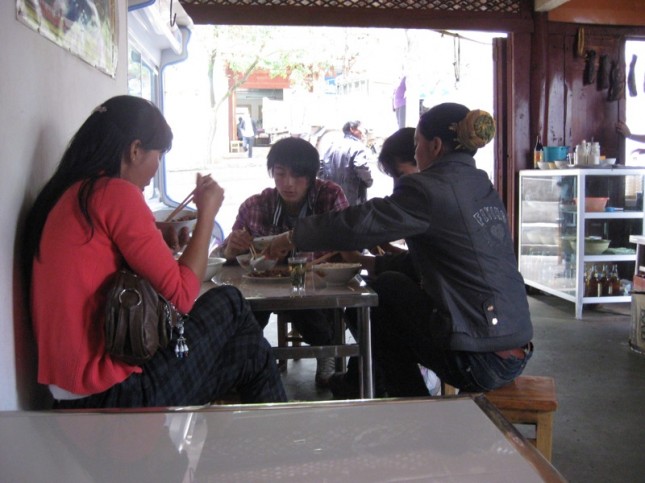
I found the place on my first day in Shaxi, when I had walked into Sideng town from Mr. Wu’s lodge looking for a late lunch. Every other place in town seemed to have finished serving, but there were still three groups hunched over the place’s low tables. I stood by the kitchen’s counter for a few minutes, watching the cook dish up bowls of simple beef soup and plates of meat and vegetables, then ordered a plate of stir-fried beef and a serving of lotus root, pointing out the dishes at other customers’ tables. They came to the table one at a time, as each was finished, and I ate them with a bowl of fluffy white rice and a small glass of delicate green tea. The food was ridiculously delicious. The sliced lotus root was perfectly cooked, both crunchy and tender, with a slight sweetness offsetting the pickled greens that had been added to the dish, and the beef was rich and flavorful, with a similar pickle mixed in along with copious amounts of sliced scallion and a scattering of hot peppers.
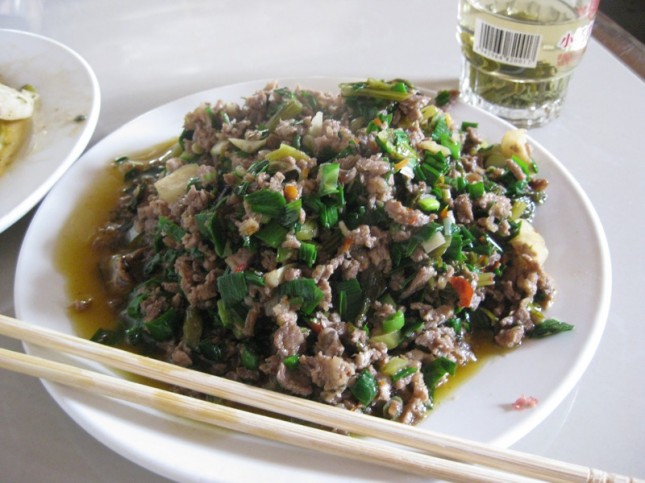
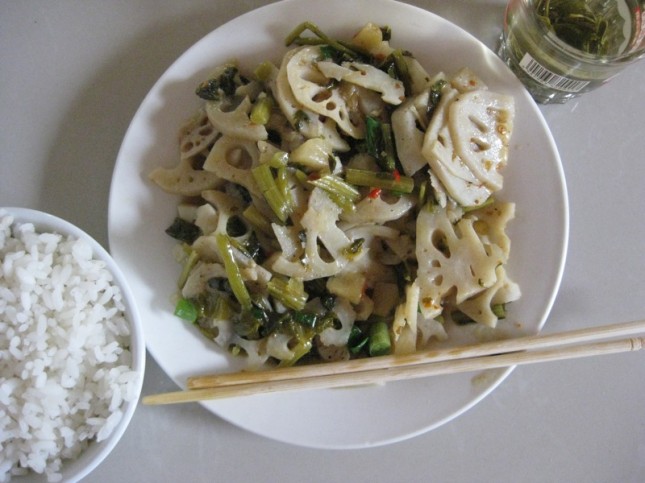
By the time I finished my lunch, the restaurant had emptied out, and it had begun to rain lightly. I asked the cook if I could stay until the weather turned, then settled in on the couch, refilling my tea from a selection of hot water bottles and reading my magazine while the women sat outside, under a makeshift awning, cleaning vegetables. By the time I left, an hour later, I felt more relaxed than I had felt in days.
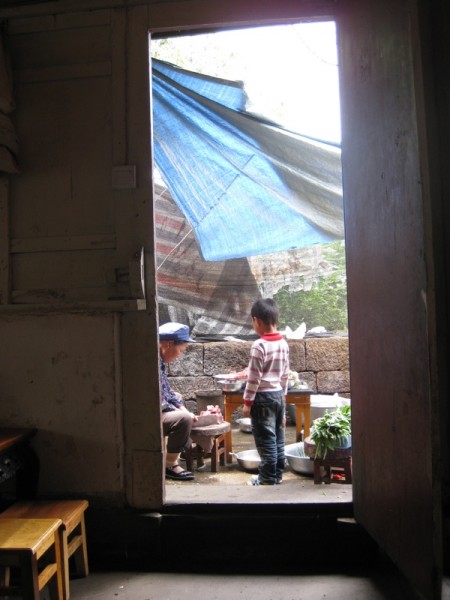
The following week, when I took my mom and her partner, Jennifer, to Shaxi as part of a week-long exploration of Yunnan, out first stop was lunch at Long Feng. I ordered both the lotus and the beef again and added in a dish of simply cooked eggplant seasoned with a touch of vinegar and another of lightly stir-fried napa cabbage. When we finished, Jennifer declared it one of the best meals she’d ever eaten. So the following day, we went back for dinner. This time, the restaurant was packed with a party of eight and another of sixteen, and we had to wait for almost forty-five minutes before the cook could take our order. In the interim, I stood next to the kitchen and watched her cook. With the night in full swing, she had three different woks going at once. One, which she had used at lunch, was embedded in the kitchen counter and fueled by a nine inch-wide charcoal briquette, which gave off a constant, low flame. The second, on tripod, was gas-fueled and produced a hot flame which shot up seven or eight inches into the air when a wok was not sitting on top of it, pushing its heat down and outward. And the third, sitting on a small table, was a simple electric hot plate, which seemed to be turned to a low setting. As she worked, the cook rotated her three woks among these heat sources, taking one from the high flame, where she seared meat and quick-cooked vegetables, to the lower one, where the ingredients sat to continue to heat as the flavors melded together, or moving a wok of just cooked-through potatoes from the lower heat to the high to crisp their edges.
When the cook had finally filled the orders of the larger parties, I ordered the beef dish from the day before along with a serving of local mushrooms, which I had seen in a bowl in the restaurant’s cold case, Chinese water spinach, and two dishes I’d seen other guests eating that night, a cold cucumber dish dressed with vinegar, chile oil, and sichuan peppercorns, and latke-like pancake of thinly-sliced potatoes.
The bright, crunchy cucumbers arrived first, followed by the mushrooms, which had a delicious, meaty flavor reminiscent of chanterelles, along with the vegetables, and then, finally, the beef and the potatoes. The potato pancake had been sprinkled with chili powder, sesame seeds, scallions, and salt. The edges were crisp and brown, but the middle of the pancake was still soft and pliant, each slice of the red and white-striped tuber slicked with oil. We tore into it with our chopsticks and immediately forgot about everything else on the table. As we ate, grabbing huge mouthfuls, I realized that of all the dishes we’d had, this would probably be the easiest to recreate. Unlike the others, it did not have dozens of sauces and seasonings thrown in so quickly that I couldn’t keep up or ingredients I didn’t recognize. It was simple, and pure. And just maybe, as Jennifer had said, one of the best things I’d ever eaten.
Recipe: Long Feng’s Potato Pancake
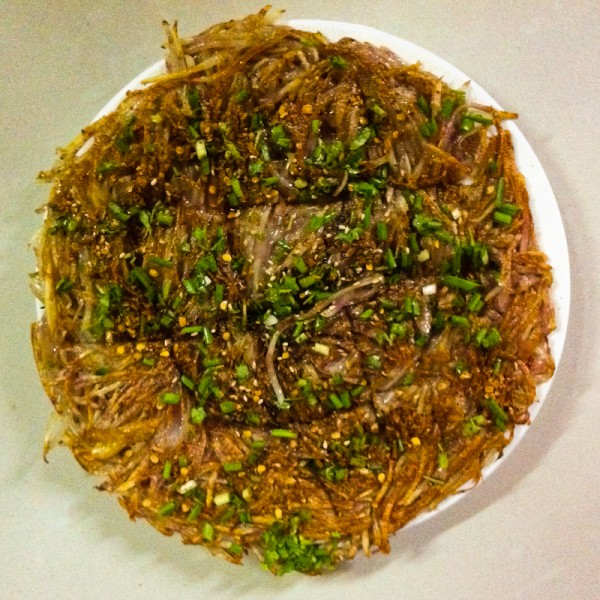
Photos: Georgia Freedman (5), Josh Wand (1)



